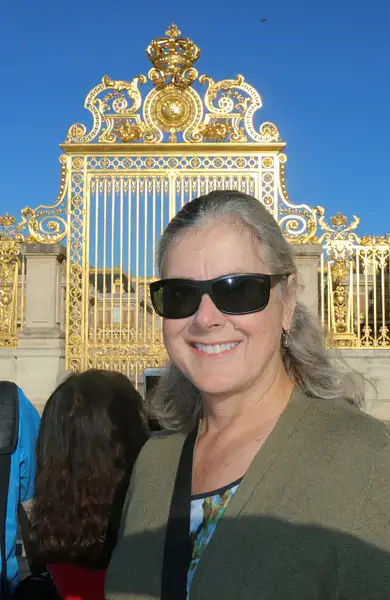


The Gardens of Versailles |
The Gardens of Versailles-Latona Fountain and Parterre
The Latona fountain was the result of the desire of Louis XIV. He wanted in the centre of his Garden a fountain telling the story of the childhood of Apollo, the sun god that he had chosen for his emblem. To create this fountain, Louis XIV had a pond dug for Louis XIII transformed by progressively installing water features and sculptures produced by the Marsy brothers. The Latona fountain went through several stages before it acquired its present form. In 1667, it was the Frogs fountain. From 1668 to 1670, the first Latona fountain appeared; Latona was then on the same level as the other figures and facing the Palace. From 1687 to 1689, Jules Hardouin-Mansart created the present fountain by turning Latona around and placing her on the top of a marble pyramid.
|
Tom in the Gardens of Versailles |
The Gardens of Versailles-The Grand Canal stretches to the horizon |
The Palace of Versailles |
The Palace of Versailles-Indian-British artist Anish Kapoor's "Dirty Corner" sculture |
Versailles-Sky Mirror |
Palace of Versailles |
Gardens of Versailles |
Gardens of Versailles |
Georgia admires the gardens of Versailles |
Georgia exploring the labyrinth Gardens of Versailles |
Gardens of Versailles-The Ballroom Grove
Laid out by André Le Nôtre between 1680 and 1683, the open-air Cascade Ballroom is also called the Rocaille Grove, because of the millstones and the sea shells brought back from the coasts of Africa and Madagascar over which the water pours down in a cascade. The marble “island” in the centre, easily accessible, was used for dancing, an art in which Louis XIV excelled. The musicians played above the cascade and, facing them, an amphitheatre with grassy rows of seats enabled the spectators to sit down.
|
The Gardens of Versailles-Bacchus Fountain
Also called the Autumn fountain, it is the same size as the three other fountains dedicated to the seasons and near the Royal Walk. Bacchus, a figure of Roman mythology, teaches the cultivation of the vine throughout the world. The god of wine and drunkenness, he symbolises the harvest and is surrounded by small satyrs, half child and half goat.
|
The Gardens of Versailles-The Colonnade Grove
Build from 1685 on by Jules Hardouin-Mansart, the Colonnade replaced a grove designed by Le Nôtre in 1679: the Springs Grove. A peristyle accompanies the 32 marble columns. The triangular tympani between the arcades are decorated with low relief carvings depicting children. The arch stones are adorned with heads of nymphs and naiads. The famous group in the centre on a circular marble base was executed between 1678 and 1699 by Girardon: Proserpine Ravished by Pluto.
|